
Space Sciences
Fe-rich X-ray amorphous material records past climate and persistence of water on Mars
A. D. Feldman, E. M. Hausrath, et al.
This groundbreaking research by Anthony D. Feldman and colleagues explores the intriguing world of X-ray amorphous material found in Martian sediments. With implications for understanding the ancient climates of Mars, their study highlights how the formation and longevity of this material vary with climate conditions, suggesting a timeline of past aqueous alterations and environmental changes on the planet.
Playback language: English
Introduction
The Curiosity rover's CheMin instrument has revealed that X-ray amorphous material constitutes a significant portion (15-73 wt%) of rocks and sediments in Gale Crater on Mars. This material is characterized by variable iron and silicon richness, but it is typically poor in aluminum, suggesting a predominantly mafic source. While amorphous materials can form through various processes, including volcanic glass formation and hydrothermal alteration, the presence of volatiles detected by the SAM instrument suggests that at least some of this material is composed of secondary weathering products formed in the presence of water. The abundance of this amorphous material in Noachian to early Hesperian sediments is unexpected because amorphous materials are generally considered metastable and prone to conversion into more thermodynamically stable, crystalline phases. Previous research on terrestrial soils has identified amorphous aluminosilicates as precursors to crystalline clay minerals, with the formation and persistence of aluminous amorphous material being favored by colder temperatures. However, the climatic effects on the formation and persistence of Al-poor, Fe-rich amorphous material, as found in Gale Crater, remain poorly understood. This study aims to address this gap by examining the impact of time and climate on the formation and persistence of Fe-containing, Al-poor amorphous material using terrestrial analogs.
Literature Review
Existing research indicates a strong correlation between the formation and persistence of amorphous aluminosilicates and environmental conditions. Cooler temperatures favor their formation and preservation, while warmer climates lead to the formation of more crystalline secondary phases. Studies on terrestrial soils have shown amorphous aluminosilicates to be precursors to crystalline clay minerals, suggesting a kinetic control on their formation under cold and wet conditions. Previous work has examined the formation of amorphous materials in various terrestrial settings, such as glacial sediments, Hawaiian soils, and paleosols, but fewer studies have focused on the type of Al-poor, Fe-rich amorphous material common on Mars. The presence of volatiles and alteration products associated with Martian amorphous materials also supports a role for aqueous activity in their formation. However, the specific environmental conditions that promote the formation and long-term preservation of this type of amorphous material on Mars remain a key question in Martian geology.
Methodology
To investigate the impacts of climate and time on the formation and persistence of Fe-rich, Al-poor amorphous materials, the researchers examined soils from three distinct climate zones: Mediterranean (Klamath Mountains, California), subarctic (Tablelands of Newfoundland, Canada), and desert (Pickhandle Gulch, Nevada). These sites offer a range of environmental conditions and soil ages (approximately 12 ka to >50 ka). Serpentine soils were chosen as analogs due to their chemical similarity (Mg/Fe/Si-rich and Al-poor) to Martian materials. The study employed a multi-faceted approach that included:
1. **Field Site Selection and Characterization:** Four serpentinite bodies across the three climate zones were selected for investigation. Detailed soil descriptions including Munsell color, pH, organic content (LOI550), and soil texture were recorded. Parent material samples were collected for comparison with the resulting soils.
2. **Mineralogical Analysis:** X-ray diffraction (XRD) analysis was performed on both bulk soil and the clay-size fraction (<2 µm) of the soil samples. Oriented-mount XRD was used to identify and quantify phyllosilicate minerals. Rietveld refinement was applied to the clay-size fraction XRD patterns to quantify crystalline phases and estimate the abundance of amorphous material. High-resolution transmission electron microscopy (HRTEM) was used to confirm the presence of amorphous and nanocrystalline materials.
3. **Chemical Analysis:** Bulk chemical analysis of the parent material and clay-size fraction samples was performed using ICP-MS. A suite of selective chemical dissolutions was applied to the bulk soil samples to determine the distribution of iron within different soil reservoirs. This included hydroxylamine hydrochloride (to measure Fe and Si in amorphous material), citrate dithionite (to measure total Fe in amorphous and crystalline oxides), and sodium pyrophosphate (to measure organically bound Fe). These dissolutions provide insights into the crystallinity of iron-containing phases and the relative abundance of amorphous Fe.
The data analysis involved comparing the abundance of amorphous Fe and Si, along with the crystallinity indices, across different climate zones and soil ages to establish a relationship between environmental conditions and the formation/preservation of the amorphous materials. Statistical analyses were conducted to analyze the relationships between soil properties and environmental conditions. HRTEM was used to directly visualize the amorphous and nanocrystalline materials in selected samples. Finally, a conceptual model showing the combined effects of climate and time was developed.
Key Findings
The study revealed a clear relationship between climate, time, and the formation and persistence of Fe-rich amorphous material in terrestrial soils.
1. **Aqueous Alteration:** In situ aqueous alteration is a necessary condition for the concentration of iron into the clay-size fraction, indicating that liquid water is crucial for the formation of these secondary minerals.
2. **Climate Control:** Cooler and wetter climates (such as the subarctic climate in Newfoundland) significantly promote the formation and persistence of Fe-rich amorphous material. In contrast, warmer climates (such as the Mediterranean climate in California) lead to the rapid formation of crystalline Fe-oxyhydroxides and smectites, while the dry desert climate of Nevada shows minimal to no formation of amorphous material. The abundance of amorphous material was highest in the Tablelands soils, which experienced a subarctic climate.
3. **Time Dependence:** While soil age influenced the degree of weathering, the overall impact of climate was far more significant. Even in older soils of the Klamath Mountains, the amount of amorphous Fe remained substantially less than that observed in the younger soils of the Tablelands. The high abundance of amorphous iron (FeH) in the Tablelands soils is significantly greater than its parent material, suggesting in-situ formation, while in the Klamath Mountains and Pickhandle Gulch, it is at or below parent material levels.
4. **Chemical Composition:** The bulk chemical composition of the clay-size fractions from the Klamath Mountains and Tablelands exhibited a similar Al-poor and Fe- and Si-rich composition to the amorphous material found in Gale Crater, suggesting relevance of the terrestrial analog to the Martian setting. In the Klamath Mountains and Tablelands, iron is significantly enriched in the clay-size fraction relative to its parent material, while magnesium is depleted, which supports the in-situ formation of Fe-rich secondary phases such as amorphous material and Fe-(oxyhydr)oxides. The Al content in the Pickhandle Gulch soil, however, is much higher relative to the parent material, indicating dust influx. This suggests a difference in the provenance of the amorphous materials.
5. **XRD Patterns:** The XRD patterns of the clay-size fractions from all studied soils showed an amorphous hump, similar in position to those observed in Gale Crater samples. The positions of these humps are dependent on composition, with those richer in Fe and poorer in Si having humps centered at higher angles (26° and 30°2θ). This reinforces that the terrestrial amorphous material is a relevant analogue for that found on Mars.
6. **HRTEM Confirmation:** HRTEM analysis confirmed the presence of both truly amorphous and nanocrystalline materials within the clay-size fraction samples from the Klamath Mountains and Tablelands, thereby confirming the X-ray amorphous observations.
The researchers also found differences in the ratio of amorphous Fe to crystalline Fe-(oxyhydr)oxides across the different sites. This ratio was greater than 0.95 in the Tablelands, indicating the majority of Fe was present as amorphous material. In contrast, this ratio was much lower in the Klamath Mountains, indicating that Fe is primarily found in crystalline secondary phases.
Discussion
The findings strongly suggest that the abundance of Fe-rich amorphous material in Gale Crater is consistent with past cool and wet conditions, followed by a shift to long-term cold and dry conditions. The subarctic Tablelands soils, which best represent the Martian analog, exhibited a significantly higher abundance of Fe-rich amorphous material than the warmer Klamath Mountains soils. The arid conditions at Pickhandle Gulch further demonstrate the critical role of liquid water in the formation of these materials. These findings support the hypothesis that a significant period of aqueous activity occurred on early Mars under relatively cold conditions. The similarity in chemical composition and amorphous hump shapes between the terrestrial analogs and the Gale Crater samples suggests that the observed Martian amorphous material may have formed under analogous climatic conditions. The prevalence of similar nanophase Fe-oxides and amorphous Fe-silicates elsewhere on Mars suggests a broader application of this interpretation across the Martian surface. Further research using returned samples from Mars is necessary to validate these findings and conduct more detailed comparisons between terrestrial and Martian materials.
Conclusion
This study provides compelling evidence that the formation and persistence of Fe-rich X-ray amorphous material on Mars are closely linked to past climatic conditions. The results suggest that a cool and wet environment was prevalent during the formation of this material, followed by a long period of cold and dry conditions that facilitated its preservation. The terrestrial analog soils effectively demonstrate the climatic controls on the formation and persistence of this material. Future research should focus on more detailed analyses of returned samples from Mars to refine our understanding of past Martian environments and further verify the proposed climatic model. This also suggests a need to focus on the role of variable dust inputs and the degree of aqueous alteration of parent material on the relative abundances and locations of this type of amorphous material.
Limitations
The study relies on terrestrial analogs to understand Martian processes, which may have inherent limitations. While serpentine soils offer relevant chemical similarities, the exact processes of formation and preservation of amorphous material on Mars might differ due to variations in atmospheric pressure, gravity, and the presence of other factors. Additionally, the age estimations for some soil sites are based on indirect methods, which may introduce uncertainties. However, these limitations do not detract from the primary conclusion that cooler and wetter conditions favor the formation and preservation of the type of Fe-rich amorphous material found on Mars.
Related Publications
Explore these studies to deepen your understanding of the subject.







